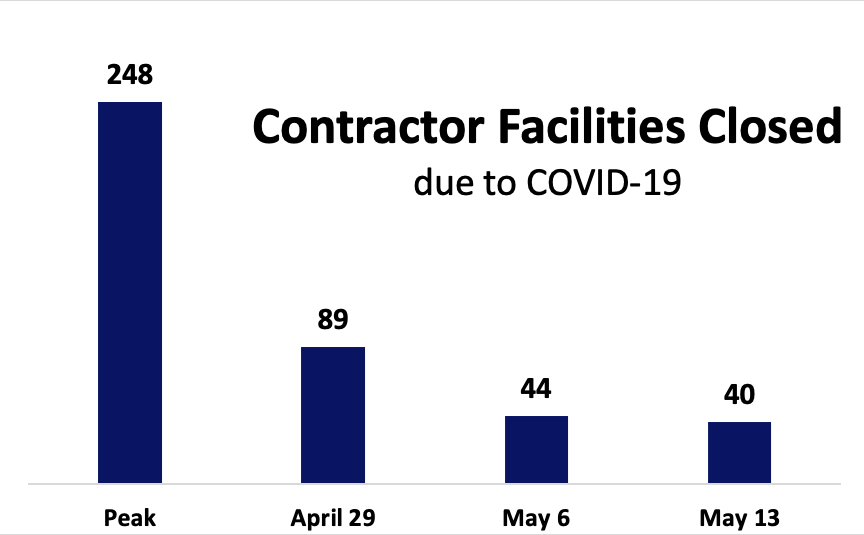
Breaking Defense graphic from Defense Contract Management Agency (DCMA) data
WASHINGTON: The number of defense contractors reopening after COVID-19 quarantines now exceeds the number of new shutdowns, the Army’s senior acquisition official said in an interview. That is happening, Bruce Jette told me, because industry is learning and adapting. New health precautions, from disinfecting tools between shifts to social distancing on the factory floor, should contain further outbreaks of COVID-19 and keep Army programs on track, he said – even if there’s a new upsurge in infections nationwide.
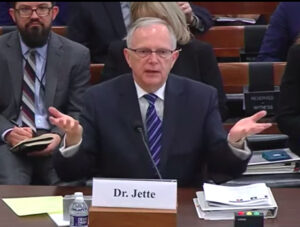
Bruce Jette, the Assistant Secretary of the Army for Acquisition, Logistics, & Technology, testifies to the House last week.
According to daily updates from Defense Contract Management Agency, Jette said, “the openings are outweighing the number of closings, and total number of closings is down significantly, so things are improving quite a bit.”
Of 10,509 facilities large and small that DCMA is tracking, 248 had closed at some point — but only 40 are still closed. The number of reopenings has exceeded the number of new closings since April 20.
But, I asked, what if there’s another spike, whether from states relaxing shutdown orders or a change in weather come the fall? Because of the new precautions now in place, Jette told me, “I would say that in the long run, if we had some degree of a resurgence, I don’t think it would be as marked as the first one.”
Learning To Cope
There was an initial wave of shutdowns in the first days of the pandemic, Jette said, because a single case of COVID-19 might require putting the entire workforce at a facility into quarantine, particularly at smaller companies. That wasn’t a panicked reaction, but a reasonable precaution. Workers had been mingling freely in close quarters, most coronavirus carriers were asymptomatic, and virtually no reliable tests were available. A company facing a single case had no way of knowing who else might already be infected.
But that’s no longer true, Jette went on. Private companies and government agencies alike have now broken up large groups of workers into smaller ones, creating “bubbles” in which any contagion can be contained.
“For example, in the past, one shift came in and started using the tools from the other shift,” Jette said, as one example. “Now, between shifts, a cleaning team comes in and disinfects all the tools.”
Wiping down shared equipment, surfaces, and spaces is just one part of a multi-layered defense against contagion. Workers on the same shift who once all came in and out together, chatting in close quarters and shaking hands, may now arrive and leave on staggered schedules so they can stay six feet apart at all times. Workflows have been changed and workstations physically moved, where possible, to permit social distancing on the factory floor. Employees who must work side-by-side wear masks and gloves.
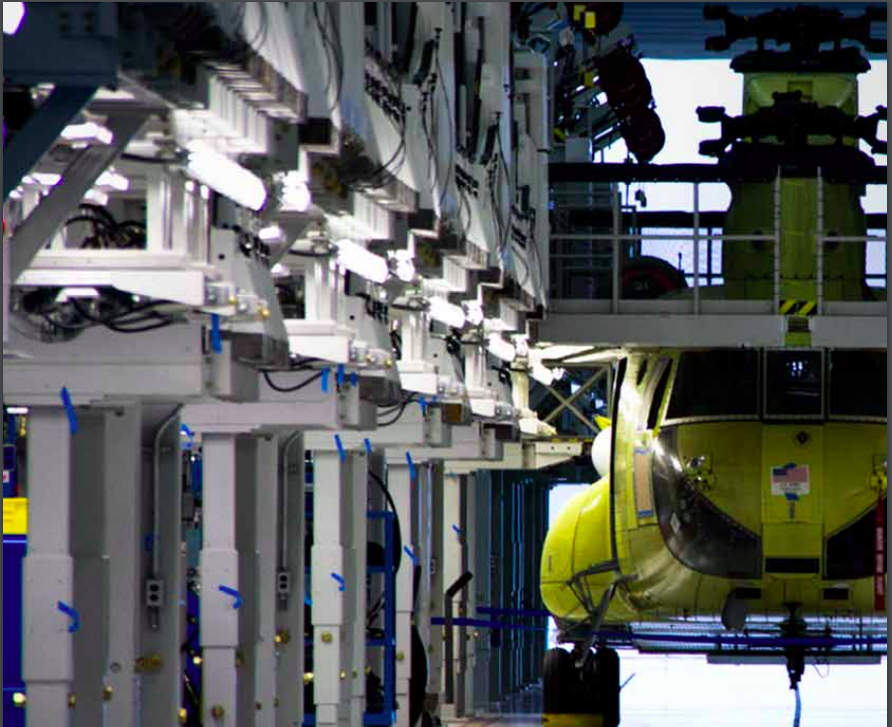
A CH-47 helicopter under construction at Boeing factory outside Philadelphia, which briefly shut down do to COVID-19.
Those precautions reduce the chance of someone catching the coronavirus in the first place – and just as important, they make it harder for one infected employee to spread the disease, especially to colleagues outside their “bubble.” So when somebody does get sick, you only need to quarantine their particular team, not shut down the whole factory.
“If somebody in the bubble comes down [with COVID],” he said, “ only that bubble ends up isolated.”
Even Pentagon offices like Jette’s own are getting cleaned more frequently and more thoroughly, he told me, even when no one working in them has actually gotten sick. “[Even when] nobody has become infected in a particular office,” he told me, “we are having a cleaning team go through and do one office here, one office there, and just do a thorough wipe-down to make sure that there’s nothing that got into that office undetected.”
These precautions aren’t excessively onerous, disruptive, or costly, Jette said. They’re just things nobody had thought about doing before – but now they might be useful even after the pandemic is under control.
“I don’t see it being a significant burden on the system; it was just something we didn’t see was an issue before,” he said, “[but] I may well help us have fewer flus and colds if we just continue the same practice.”
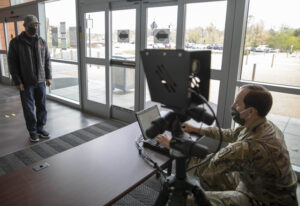
Using a modified thermal sensor to check a visitor’s temperature for fever.
Dealing With Disruption
Industry may be adapting well, but a global pandemic is still extraordinarily disruptive. Like the rest of the Defense Department, the Army is closely tracking not only its prime contractors but the smaller subcontractors and sub-sub-contractors, which are much more fragile. To date, the Army has pumped $167.5 million into small businesses to help them ride out COVID disruptions.
“There have been some cost implications to the government,” Jette said, “but mostly with respect to the CARES Act,” which ensures workers at facilities closed by COVID are paid instead of let go.
The main way the Army has helped out companies is by making payments they already had coming, just ahead of schedule. For example, Jette said, the service has started writing checks to contractors every 15 days instead of the normal 30. It’s also increasing progress payments, normally limited to 80 percent of total contract value (85 percent for small business) to 90 percent (95 for small business).
“Cash flow was one of those things we concerned ourselves with,” Jette said. “Congress gave us flexibilities there. There were things passed down from OMB in the White House that gave us some flexibility as well.”
To help figure out which subcontractors might be in trouble, the Army’s prime contractors have opened their books and shared information with the service, far beyond anything they were contractually obligated to do, Jette said. Since the early days of the pandemic, even before shutdowns began, he’s been getting a daily report on the health of subcontractors, which now routinely runs over 60 pages.
“The primes … were all very cooperative in trying to give us visibility down to the lowest level supplier,” Jette said. “It’s really been helpful for us, because it helps us get a better gauge on what we have to do if something goes awry.
In some cases when a subcontractor shuts down, the primes can find an alternative supplier. But despite the huge size of the defense industrial base, Jette said, there are single points of failure where only one company that’s been formally qualified to build a certain part or perform a certain industrial process. It takes time to get a back-up supplier up to speed – sometimes longer than the 16.8 days that, on average, it takes a quarantined facility to reopen.
That has resulted in delays, Jette acknowledges, but, so far, Army programs are finding ways to make up the time elsewhere in their schedules and still deliver new weapons to the troops on time – what’s called First Unit Equipped, or FUE.
“Delivery schedules on some products have slipped a little bit right…but at this point, none of them has assuredly slipped the FUE,” Jette told me. “As of right now, the vast majority of challenges that we’ve had with COVID, we’ve been able to accommodate within the current contracts with minor changes.”
But the factories aren’t the only part of the system that has to function. “The most significant thing isn’t production,” Jette said. “It’s trying to get all the testing done to make sure that all the systems work.”
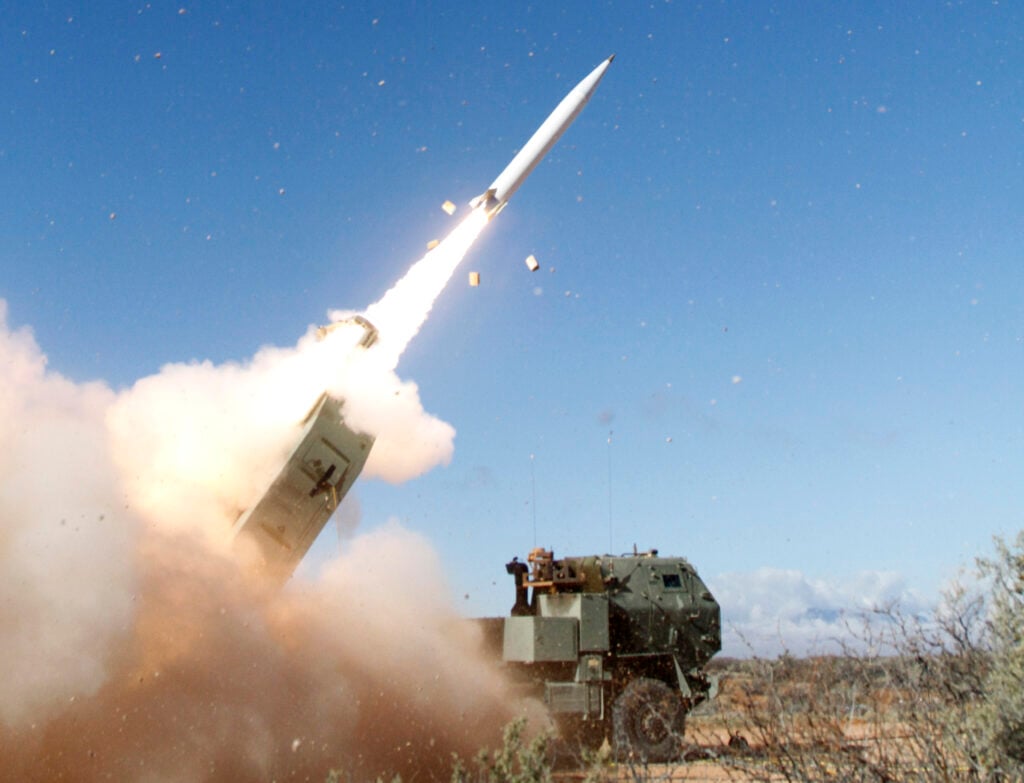
Lockheed’s prototype Precision Strike Missile (PrSM) fires from an Army HIMARS launcher truck in its first flight test, December 2019.
While some testing takes place in labs, what’s most complex is operational testing, which puts a new technology in the hands of soldiers in the field to see how it works in for a real unit, interacting with all the rest of that unit’s gear, conducting a realistic mission in realistic conditions. That requires bringing together not only the soldiers but technical specialists from the manufacturers, Army program offices, and Army testing organizations across the country.
“Those are not simple to just change or move around, [and] that’s part of what we’ve struggled with,” Jette said. “In some cases, we have suppliers who provide a capability and it’s ready to be tested and we just don’t have the facilities or the units available yet for full testing.”
Officials need adequate test data before they can approve a program to start production – what’s known as a Milestone C decision. But, Jette said, if you have to delay that formal approval, you can compensate by getting ready to jump-start manufacturing as soon as you have the go-ahead. The contractor can even start production ahead of Milestone C at its own risk, if it’s confident that testing will not find any significant problems.
At some point, it comes down to what kind of risk you’re willing to take. If you rev up your manufacturing base before testing is complete, but then testing discovers a problem you have to fix, you may have to make expensive, time-consuming changes to your design, to your production process, or even to items already built. But if you wait for all the testing to get done, no matter how long it takes, you may not get the kit to troops on schedule.
Unprecedented Stresses
It’s a difficult and stressful time; Jette can’t recall anything like it in his 30 years in the defense sector.
“At least based on my experience which goes back to the early ’90s,” he told me, “you may have had strains on a particular vendor, [but] this is fundamentally a nationwide challenge that covers all of our programs.”
“I can’t think of any time where we had such a longstanding challenge to keeping programs fully operational,” he said.
“Probably the closest thing,” he said, is when Congress can’t pass defense funding bills on time and passes a stopgap Continuing Resolution. A CR essentially puts spending on autopilot at last year’s levels with no ability to start new programs, ramp up existing ones, or cancel failing ones. Like the pandemic, a CR can impact every function of the Defense Department, or even the entire federal government, for weeks or months on end.
But funding problems don’t threaten the health and safety of every worker the way the pandemic does. “In this case, we have to consider the financial underpinnings, but we also have to consider the impact to the people themselves.”
“Our most valuable resources are people,” Jette said. “If I don’t have good people, I’m not getting good work done. I want to make sure those people want to work here, and a big piece of that is giving them a safe and healthy environment.”
Army eyes TBI monitoring, wearable tech for soldiers in high-risk billets
“We are also looking at what additional personal protective equipment we can provide to our folks, especially instructors and others who are routinely exposed to blast pressure,” said Army Secretary Christine Wormuth.


























